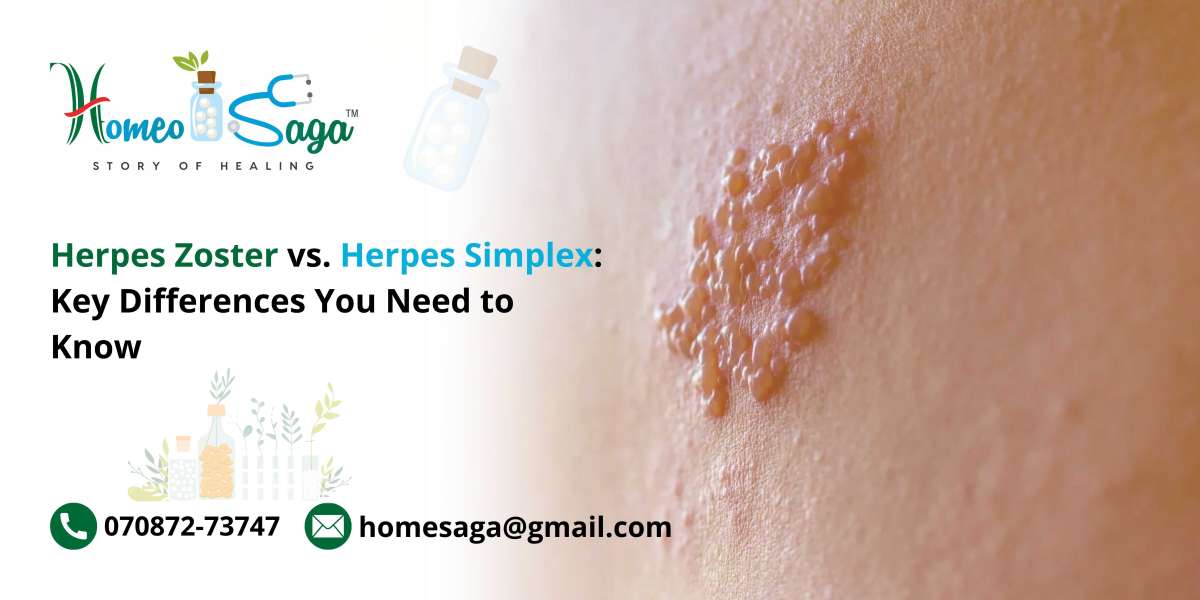Herpes Zoster and Herpes Simplex are two terms that often cause confusion due to their similar names and origins. However, they are distinct viral infections with unique characteristics and implications for health. In this article, we will explore the critical differences between Herpes Zoster vs. Herpes Simplex, including their causes, symptoms, transmission, and treatment options.
What Are Herpes Zoster and Herpes Simplex?
Herpes Zoster, commonly referred to as shingles, occurs when the varicella-zoster virus—responsible for chickenpox—reactivates in the body. After a person has chickenpox, the virus remains dormant in nerve tissues. It can reactivate later in life, leading to Herpes Zoster.
Herpes Simplex, on the other hand, encompasses two main types: Herpes Simplex Virus Type 1 (HSV-1) and Herpes Simplex Virus Type 2 (HSV-2). HSV-1 is mainly associated with oral herpes, often causing cold sores around the mouth, while HSV-2 is primarily linked to genital herpes. Both can infect various body parts but are most recognized for their typical presentations.
Symptoms: How They Differ
The symptoms of Herpes Zoster vs. Herpes Simplex can vary widely.
Herpes Zoster Symptoms: This condition typically begins with localized pain, itching, or tingling in a specific area, followed by a painful rash that develops into blisters. The rash usually appears on one side of the body and can persist for weeks. Some individuals may experience fatigue and fever as well.
Herpes Simplex Symptoms: The symptoms depend on the type of virus. HSV-1 often leads to cold sores, while HSV-2 results in painful genital blisters. Initial outbreaks may include systemic symptoms like fever and muscle aches, but these often resolve more quickly than those associated with Herpes Zoster.
Transmission: Understanding the Spread
When comparing Herpes Zoster vs. Herpes Simplex, the transmission methods are crucial to understand.
Herpes Zoster: This virus is not contagious in the traditional sense. It can be spread through direct contact with the fluid from shingles blisters, but it typically causes chickenpox in someone who has not previously been infected or vaccinated.
Herpes Simplex: This virus is highly contagious and spreads easily through direct contact with infected skin or bodily fluids. HSV-1 can be transmitted through kissing or sharing utensils, while HSV-2 is primarily spread through sexual contact. Safe practices are essential to limit the spread of Herpes Simplex.
Risk Factors and Complications
Both Herpes Zoster and Herpes Simplex come with specific risk factors and potential complications.
Herpes Zoster: Older adults and individuals with weakened immune systems are at higher risk. One significant complication of Herpes Zoster is postherpetic neuralgia, which is characterized by ongoing pain in the affected area long after the rash has healed.
Herpes Simplex: This virus can lead to serious complications, including herpes keratitis, which affects the eyes, and in rare cases, encephalitis. Recurrent outbreaks can also cause emotional distress for those living with the condition.
Treatment Approaches
The treatment options for Herpes Zoster vs. Herpes Simplex differ considerably.
Herpes Zoster Treatment: Antiviral medications can be prescribed to reduce the severity and duration of the outbreak, particularly when treatment begins early. Additionally, vaccines are available to prevent Herpes Zoster, especially for those over 50.
Herpes Simplex Treatment: Antiviral medications are also the mainstay for managing Herpes Simplex outbreaks. These medications help control symptoms and reduce the risk of transmission. While there is no cure, effective management strategies can significantly improve quality of life.
Preventative Measures
Preventing these conditions involves different strategies for Herpes Zoster and Herpes Simplex.
Herpes Zoster Prevention: Vaccination is the primary preventive measure, particularly recommended for older adults, as it can greatly reduce the risk of developing shingles.
Herpes Simplex Prevention: Preventative strategies include practicing safe sex, avoiding intimate contact during outbreaks, and maintaining good hygiene to limit the spread of the virus.
Conclusion
In summary, while Herpes Zoster and Herpes Simplex are both part of the herpesvirus family, they are distinct in terms of symptoms, transmission methods, risk factors, and treatment options. Recognizing these differences is essential for effective management and reducing the stigma surrounding these conditions. By understanding the nuances of Herpes Zoster vs. Herpes Simplex, individuals can take proactive steps to protect their health and well-being.








